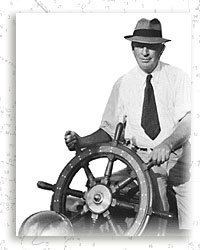Name John Alden | Role Naval architect | |
 | ||
Died 1962, Bryn Mawr, Lower Merion Township, Pennsylvania, United States | ||
John Gale Alden (1884–1962) was an American naval architect and the founder of Alden Designs.
Alden was born in Troy in 1884, one of eight children, only four of whom survived. He grew up in Rhode Island and first learned about boats when sailing a flat-bottomed rowing boat of his sister's using an umbrella as a sail. He was inspired by the local fisherman and regattas; When his family moved to Dorchester, Massachusetts in 1900 the Grand Banks fishing schooners which were docked there inspired his later designs. A compulsive doodler, as a child he made countless sketches of the boats that were later to make him famous.
When he was 18 years old his father died and he made the decision to train as a naval architect. He took courses at MIT and apprenticed with prominent naval architects Starling Burgess and Bowdoin B. Crowninshield.
In the winter of 1907, he undertook a voyage that would define his distinctive design trademark: The schooner Fame, owned by the eastern Fishing company, had to be returned to Boston when her crew of 23 men had gone down with smallpox and there was no one left to sail her. Alden put together a crew of four inexperienced young men and one old salt to undertake the journey. During the weeks that followed, they experienced appalling winter weather - 60 mile an hour winds, turning the salt spray to ice. The boat, and the crew, were man enough for the job, but for Alden the lessons learned far outweighed the value of the delivery contract: He realized how to design a boat that would be resilient in heavy seas, and what was important when a vessel was short-handed. His subsequent designs are admired not only for their grace and elegance but for their stability and for the fact that they can, generally, be sailed single-handedly if necessary.
After the voyage, Alden returned to the Burgess offices but left in 1909 to found his own company, the Alden Design Office in 1909.
The early years were difficult, putting a strain on his finances and on his marriage which broke down after only three years. Business improved in 1917 and the offices were doing sufficiently well during the 1920s to employ specialist draftsmen. Alden would discuss the requirements with the clients and make the initial sketches, then handing over the work to the draftsmen. Nevertheless, John stamped his own individual style on every boat that was designed by the firm.
By 1932 the Alden Design Office was known worldwide in part due to the success of the "Malabar" designs in the offshore racing scene; Malabar IV won the Newport–Bermuda race in 1923, Malabar VII won it in 1926 and Malabar X won overall in 1932, with his other designs occupying the top four places.
When Alden achieved his great success in the 1932 Bermuda race, the yachting world was already beginning to see changes in boat design. Olin Stephen's yawl Dorade, which had already won the Transatlantic and Fastnet races in 1931, was the winner in Class B. Stephens followed this with another winner, Stormy Weather which won the 1936 Transatlantic Race to Norway by a wide margin. So started a long-running rivalry between the two designers. Whereas Alden's designs depended on a certain amount of inside ballast, Stephens adopted the idea of all-outside ballast. Stephens' boats were of lighter construction, using steam bent frames, rather than the sawn frames favoured by Alden. Over the next thirty years, Alden designed over 1000 boats, of which the 744 Rena series are possibly the most admired. Eric Hiscock, a leading yachtsman of the time, said "I considered her to be one of the most beautiful yachts I had ever seen, …quite perfect in (her) sea-kindly grace and harmony".
From the 1950s onwards, Alden took an increasingly less active role in the design business, although his status as a yachtsman never diminished. He continued to race into his seventies, and enjoyed sailing one of his Sakonnet One designs until his death in Florida at the age of 78. His designs have been donated by the company to MIT's Hart Nautical Collections.
